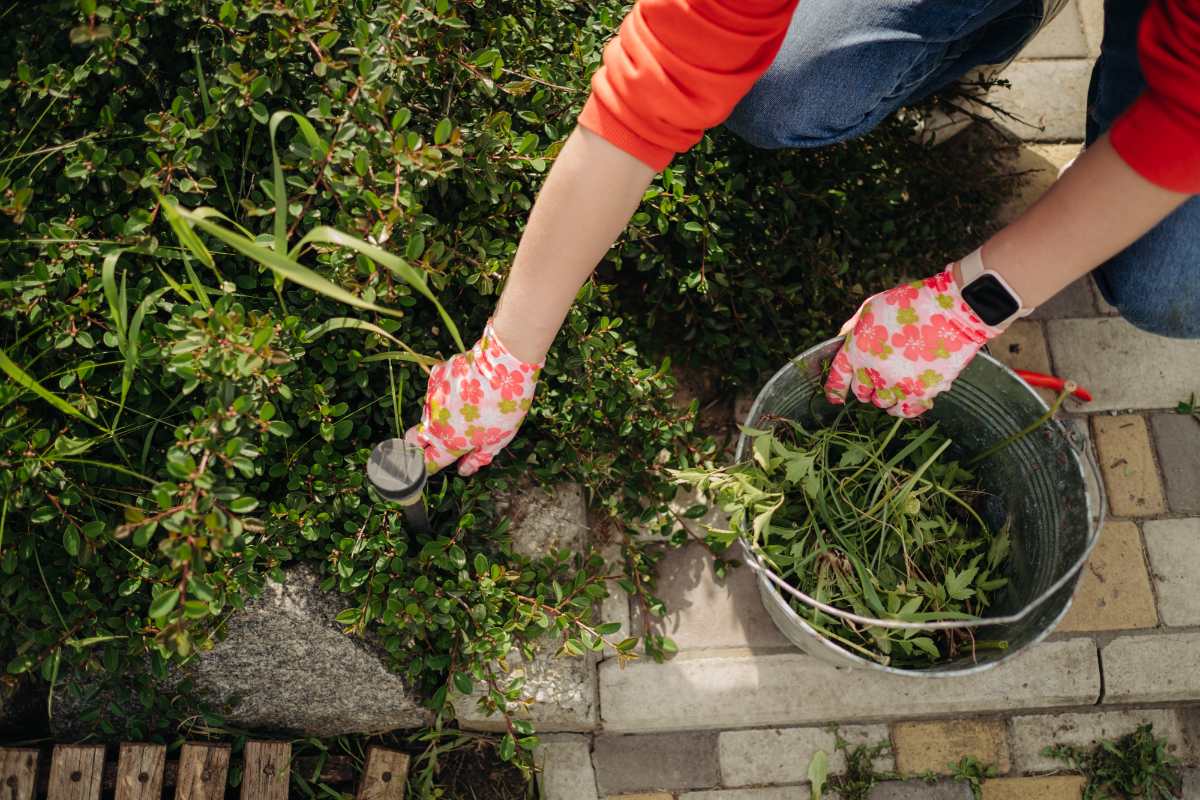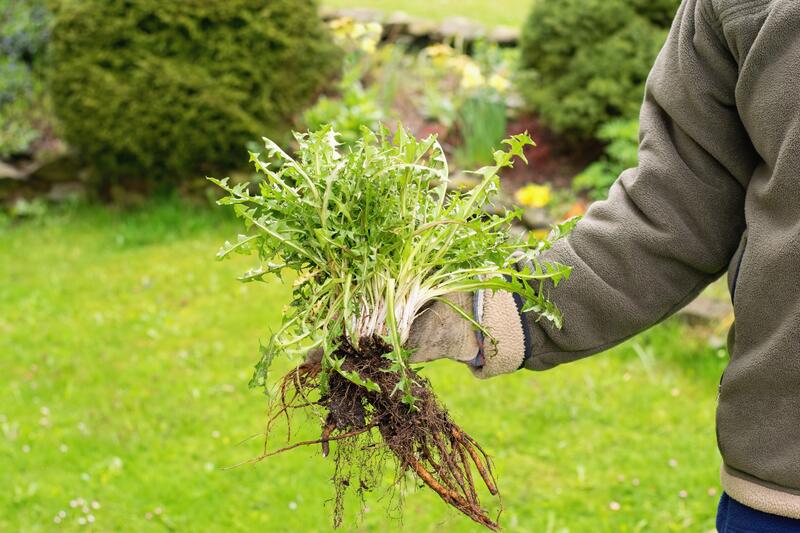
Winter weeds compete with your grass for nutrients, weakening the lawn during the cold season. To prevent this, we’ll explain how to kill winter weeds so your grass can grow healthy come spring.
Whether you prefer chemical-free solutions or don’t mind using chemicals now and then, we have you covered. With expert insights, we’ll explain how to treat your yard with natural remedies and chemical herbicides, giving you options for how to help your lawn overwinter weed-free.
Weeding out pesky plants can be a labor-intensive chore, so if you don’t know where to start or don’t have the right tools, let a LawnStarter pro treat the weeds in your yard.
How to Kill Winter Weeds Naturally
Eco-friendly weed treatments allow homeowners to avoid using chemicals that can harm the environment. From homemade solutions to mulch and mowing, here are a few natural options to get rid of the weeds in your yard without harmful chemicals:
Use a Vinegar Solution

Vinegar that contains at least 20% acetic acid is an effective weed-killer. Check that the acidity is high enough; otherwise, the vinegar won’t be sufficient to kill the weeds.
Here’s how to use a homemade vinegar weed killer recipe:
- Mix 1 tablespoon of dishwashing soap with 1 gallon of vinegar.
- Pour the mixture into a spray bottle.
- Spray onto the weeds.
When applying your vinegar solution, target the weeds carefully. Vinegar is a non-selective herbicide, so it will kill your grass along with the weeds if you’re not careful. You may have to make multiple applications to kill the weeds. Apply on a warm, sunny fall day for best results.
Pro Tip: Horticultural vinegar contains a high concentration of acetic acid, which can burn your skin and eyes. When you apply vinegar, wear protective gloves, goggles, and long-sleeved clothing.
Apply a Citrus Solution
Pouring a citrus solution over winter weeds can kill them, especially if you mix it with vinegar to increase its potency.
To make a homemade lemon juice herbicide, mix these ingredients:
- 3 tbsp. lemon juice
- 2 tbsp. liquid dish soap
- 1 oz. rubbing alcohol
- 2 cups white vinegar (5%)
Pour the lemon juice mixture into a bottle and spray it on the weeds. When you apply natural solutions made with basic kitchen ingredients like lemon juice and vinegar (5%), expect to make multiple applications before you weaken the weeds enough to kill them.
Pro Tip: For a stronger solution, purchase an organic weed killer with d-limonene (citrus oil) as the active ingredient.
See Related: How to Make Homemade Weed Killer
Be Strategic With Your Lawn Care
“Prevention through proper management practices is the best way to avoid weeds in your lawn,” says Erin Smith, horticulture Extension agent with Texas A&M in Denton. Implement these basic lawn maintenance practices to prevent most winter weeds:
- Apply fall fertilizer at the right time
- Mow at the right height
- Water sparingly in fall
- Ensure your grass gets enough sunlight
Thick, lush grass growth blocks the sunlight, space, and nutrients that weeds need to grow. By taking care of your lawn, you encourage healthy grass, which acts as natural weed prevention.
Remember: Avoid overwatering, which harms your grass and encourages weed growth.
Mulch to Prevent Weeds

Mulching is a key strategic weed prevention practice. A layer of mulch blocks sunlight from reaching the soil, which prevents common winter weeds in mulched beds. The best time to mulch is early or mid-fall, before the soil freezes.
Organic mulches break down over time, but as they do, they provide nutrients to your soil, offering additional benefits to your landscape.
Common types of organic mulch include:
- Pine needles
- Straw
- Tree bark
- Wood chips
Another effective way to stifle weed growth is with inorganic mulches. Although they don’t provide nutrients to your soil, they last many years, unlike most organic options.
Examples of inorganic mulch include:
- Pea gravel
- Rubber mulch
- Rocks
See Related:
Mow to Prevent Flowering
It may seem strange to mow when it’s still chilly outside, but annual winter weeds set seeds in late winter and early spring. Mowing in early spring helps keep some weeds from flowering and therefore producing seeds, preventing them from spreading.
Hand-Pull Weeds

“Physical removal (is) the most natural way (to eliminate) winter weeds,” says Smith. Winter “annual weeds will decline and die after the temperatures warm (in spring) but will drop seed before they die and come back up when the temperatures cool (in fall),” she says.
Hand-pulling weeds before they flower, while time-consuming and labor-intensive, is a tried-and-true weed removal method. It’s best for small infestations when there are only a handful of weeds in your yard or beds.
Remove the entire plant, not just the parts above the soil line, Smith advises. If you remove the foliage without removing the roots, the weeds are likely to grow back. Timing is also crucial: “Remove weed seed before it has a chance to drop to the ground,” she says.
Here are some tools to help you remove weeds by hand:
- Hand shovel
- Garden trowel
- Screwdriver
Hand-pulling weeds also saves money that you’d normally spend on chemical herbicides.
How to Kill Winter Weeds with Herbicides
Chemical herbicides are the best option when you have a large weed infestation, since they are the most potent way to kill a large number of weeds.
Use Pre-Emergent Herbicides Before Weeds Emerge

Pre-emergent herbicides allow you to take preemptive action against weeds rather than wait until they’ve already popped up in your yard. Pre-emergent herbicides “must be applied prior to weed seed germination,” says Smith. “For winter weeds, that would be late summer [or] early fall.”
Here’s when you should apply pre-emergent herbicides, depending on where you live:
- Southern states: Late August or September
- Northern states: Late September to early October
Once a pre-emergent herbicide is applied, it forms a barrier that prevents weeds from sprouting above the soil after germination. Pre-emergents need moisture to activate, so water your lawn after application.
Pro Tip: “Match the type of herbicide to the type of weeds you are controlling and your lawn species,” says Smith.
See Related: How to Apply Pre-Emergent Herbicides
Use Post-Emergent Herbicides After You See Them
If you forgot to apply pre-emergents this year, use a post-emergent herbicide to spot-treat weeds that have popped up in your yard. There are two types of post-emergent herbicides:
- Selective herbicides target weeds without harming your turfgrass.
- Non-selective herbicides kill all plants, including your grass.
Correctly identifying the type of winter weeds in your lawn will determine the treatment your yard needs. Some selective herbicides target broadleaf weeds, while others target grassy weeds. Non-selective herbicides will kill either.
Winter post-emergent herbicides should contain these ingredients:
- Dicamba
- Imazaquin
- MCPP
- 2,4-D
Apply post-emergent herbicide treatments when the area is dry and sunny and temperatures are under 85 F. Post-emergent herbicides work most effectively on young weeds. For best results, apply them in early fall.
FAQ About Killing Winter Weeds
No. Herbicides are most effective when the ground is dry, so wait for a dry, sunny day, after the morning dew has evaporated.
Multiple factors could be responsible for why weeds are still emerging even after you’ve applied a pre-emergent herbicide. Here are the main reasons your pre-emergent may have failed:
You applied the herbicide too late.
The herbicide you are using isn’t made to treat the type of weed in your lawn.
You forgot to water your lawn to activate the pre-emergent.
If your grass is dormant, it’s too cold to apply herbicides safely. Wait until temperatures are at least 55 F to apply herbicides to your weeds.
Say Goodbye to Winter Weeds
This winter, weed out those unwanted plants in your yard with the right treatment methods. Decide if chemical herbicides or natural remedies are the best way to treat your weeds based on the infestation size and your preferred treatment method.
Don’t give in to those weedy invaders. If the weed infestation taking over your lawn is more than you can handle, contact a LawnStarter weed removal pro for expert help getting your lawn ready for spring.
Read Next:
Sources:
- “Does Vinegar Help With Controlling Weeds?” By Chip Bubl, assistant professor. Oregon State University.
- “Green Thumbs Up Events for Williamson County Announced.” By Susan Himes, writer and media relations specialist. Texas A&M AgriLife.
- Erin Smith, horticulture Extension agent with Texas A&M, Denton, TX. Personal interview.
- “Managing Winter Weeds.” By Julie Campbell, county Extension administrative assistant. NC State University Cooperative Extension.
- “Pesticide Active Ingredients Database: D-limonene.” University of California Agriculture and Natural Resources.
- “Plant Winter Weed Control Now.” By Jackie Jordan, commercial horticulture agent. Clemson University Cooperative Extension.
- “Pre-Emergence Weed Control In Landscape Beds.” The Ohio State University.
- “Winter Application of Pre-emergence Herbicide Reduces Spring Lawn Weeds.” By Heather N. Kolich, Extension agent. University of Georgia Extension.
- “Winter Weed Control.” By Katherine Whitney, author. Texas A&M AgriLife Extension.
Main Image: Hand-pull winter weeds. Image Credit: sushytska / Adobe Stock